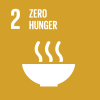
Average income of small-scale food producers, by sex and indigenous status
Last updated on 1 February 2022
This indicator is currently classified as Tier II. The Food and Agriculture Organization of the United Nations (FAO) is the main Custodian agency for this indicator in cooperation with the World Bank.
Unit of measure: Average annual income of small-scale food producers (in constant PPP 2011 USD) complemented by average income of large-scale food producers (in constant PPP 2011 USD)
Why is this indicator important?
This indicator measures the incomes of small-scale producers as a means of eliminating hunger and achieving other SDGs (e.g., poverty alleviation). Ending hunger requires long-term, sustainable food production systems and resilient agricultural practices. Developing efficient and robust food production programs to the boost agricultural productivity of small-scale producers is essential to maintain food supplies, increase incomes for poor and vulnerable groups, and feed the planet. It also contributes to strengthening rural development.
By tracking the income of small-scale producers by sex, community of reference, and enterprise size, data collected for indicator 2.3.2 enables governments to shape, prioritize, and invest in policies and measures that effectively boost agricultural productivity, drive economic growth, and eliminate hunger in particular for small-scale food producers, including women, Indigenous Peoples, family farmers, and pastoralists.
How is the indicator measured and monitored?
Data and information on income of small-scale producers is limited in many countries, but better accessible compared to the information available for indicator 2.3.1. Similarly, information is often collected at household level instead of food production unit level. The indictor can be disaggregated by sex, type of enterprise, and by community of reference.
According to the metadata brief, sources of information are either agricultural surveys, or agricultural modules in integrated household surveys (e.g., LSMS-ISA) organized by the national statistical agencies, with the necessary support from the World Bank, FAO and other international agencies. FAO has been working on computing the indicator for eight developing countries in Sub-Sahara Africa based on data collected from the Living Standards Measurement Study-Integrated Surveys on Agriculture (LSMS-ISA) surveys. Results have not been disseminated yet. In collaboration with IFAD and the World Bank, FAO also promotes the Agricultural and Rural Integrated Surveys project (AGRISurvey) which collects relevant data on an annual basis.
By Anne Hennings, peer-reviewed by FAO.
Official indicator data
The income from on-farm production activities includes income from crop production, livestock production, fisheries and aquaculture production, and from forestry production. The indicator is computed as annual income.
* Select "year" below to see the most recent data for more countries.
Other related indicators on Land Portal
In addition to the official indicator data, the following indicators provide information concerning the importance of agriculture in a given country or the distribution of land.
| Indicator | Min-Max Number of years |
Countries / Obs | Min / Max Value |
|---|---|---|---|
| Agriculture - Value Added | |||
| Employees in Agriculture - Female (% of female employment) | |||
| GDP per capita, PPP (constant 2011 international $) |
Paginación
Labor Markets and Income Generation in Rural Argentina
This paper addresses three areas of the rural labor market-employment, labor wages, and agriculture producer incomes. Findings show that the poor allocate a lower share of their labor to farm sectors than the nonpoor do, but still around 70 percent work in agriculture, and the vast majority of rural workers are engaged in the informal sector.
Nonfarm Activity and Rural Income Inequality : A Case Study of Two Provinces in China
Nonfarm activity plays an increasingly important role in rural household income. Based on data from the Living Standards Measurement Study in the provinces of Hebei and Liaoning, the authors study the distribution of nonfarm income in rural China. First, they assume nonfarm income as an exogenous transfer to total income to decompose the Gini index.
Rising Income Inequality in China : A Race to the Top
Income inequality in China has risen
rapidly in the past decades across regions, between rural
and urban sectors, and within provinces. The dynamics of
divergence across these sub-national areas have taken the
form of a "race to the top" - meaning that all
Poverty and Income Seasonality in Bangladesh
Seasonal poverty in Bangladesh, locally
known as monga, refers to seasonal deprivation of food
during the pre-harvest season of Aman rice. An analysis of
household income and expenditure survey data shows that
average household income and consumption are much lower
Sri Lanka - Agricultural Commercialization : Improving Farmers’ Incomes in the Poorest Regions
The issue of regional differences in
development has moved to the center of the development
debate in Sri Lanka, partly after the release of regional
poverty data. For the past many years, there have been
significant and increasing differences between the Western
Paginación
![]()

By 2030, double the agricultural productivity and incomes of small-scale food producers, in particular women, indigenous peoples, family farmers, pastoralists and fishers, including through secure and equal access to land, other productive resources and inputs, knowledge, financial services, markets and opportunities for value addition and non-farm employment
Indicator details
The indicator is conceptually clear, has an internationally established methodology and standards are available, but data is not regularly produced by countries.
Key dates:



